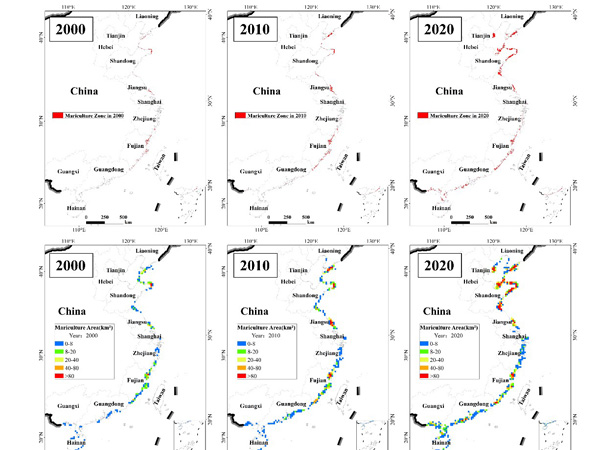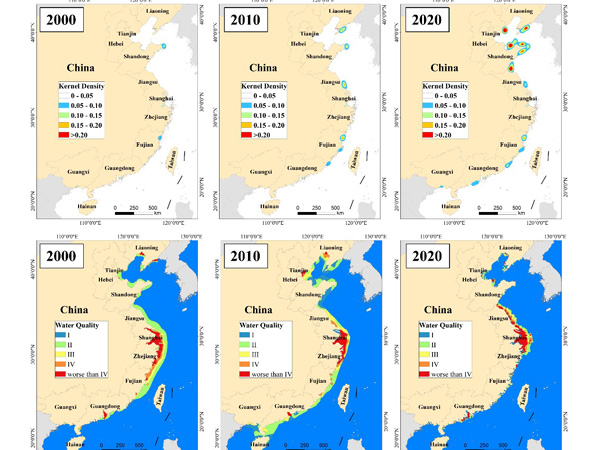The Spatial Pattern Evolution of Marine Aquaculture in China over the Past 20 Years and Its Preliminary Relationship with Coastal Seawater Quality
In the context of continuous global population growth and the increasing limitations on the development space for land-based food production systems, marine aquaculture is becoming an increasingly important sector in global food production. China is the world's largest producer of marine aquaculture, with production volumes exceeding the combined total of all other countries.
Investigating the spatiotemporal development of marine aquaculture in China and its relationship with changes in coastal water quality can not only provide valuable references for the management of aquaculture and the environment in China but also offer valuable insights for the healthy development of marine aquaculture worldwide.
Based on this, the research team of Prof. YANG Xiaomei and WANG Zhihua from the State Key Laboratory of Resources and Environmental Information System at the Institute of Geographic Sciences and Natural Resources Research, Chinese Academy of Sciences, utilized remote sensing big data to monitor and obtain spatial distribution information of marine aquaculture for the years 2000, 2010, and 2020. They further used the kernel density method to calculate and generate the marine aquaculture centers (MAC) during these three periods.
By combining this data with contemporaneous coastal water quality distribution data, they preliminarily explored the relationship between the development of marine aquaculture in China and changes in coastal water quality. The research findings were published in the Journal of Geographical Sciences and Ecological Indicators
The researchers found that over the past 20 years, marine aquaculture in China has shown an accelerated expansion trend. From 2000 to 2010, the aquaculture area increased by 152.3%, and from 2010 to 2020, it increased by 184.3%. The growth rate of aquaculture in the northern regions was higher than that in the southern regions.
In 2020, marine aquaculture in China exhibited a spatial distribution pattern of "more in the north, less in the south." Using the Yangtze River estuary as the dividing line, the northern regions accounted for 70.9% of the aquaculture area, while the southern regions accounted for 29.1%. The province with the largest marine aquaculture area was Shandong, accounting for approximately 39% of the total.
Marine aquaculture in China is concentrated in coastal areas with relatively shallow waters. Over 90% of the marine aquaculture zones are located within 20 km from the coastline, and more than 80% are in waters with a depth of less than 20 meters.
Marine aquaculture in China is highly concentrated, forming multiple MAC measured by kernel density. In 2020, these centers were located along the coastline from north to south in the following areas: Changhai in Liaoning, Qinhuangdao in Hebei, Laizhou, Changdao, Yantai, Rongcheng and Rushan in Shandong, Lianyungang and Yancheng in Jiangsu, Ningde, Putian and Dongshan in Fujian, Jiangmen in Guangdong, and Qinzhou in Guangxi. The scale and number of MAC in the northern regions were generally higher than those in the southern regions.
Good seawater quality is a prerequisite for the healthy development of marine aquaculture. The seawater quality conditions before the formation of new MAC were able to meet Class I or Class II water quality standards. However, the only MAC where the scale decreased (located in the shallow waters of northern Jiangsu) had seawater quality conditions deteriorating to Class IV after the emergence of large-scale marine aquaculture. This preliminary revelation demonstrates the close correlation between coastal water quality and the formation and scale development of MAC.
Many large-scale, high-density MAC in northern China are located in areas with fast water currents, yet the water quality conditions can still maintain Class I standards. In contrast, some relatively small-scale MAC in southern China, situated in bays with slower water currents, have water quality conditions deteriorating to Class IV. This preliminary revelation indicates that large-scale, high-density marine aquaculture areas do not necessarily lead to deterioration in seawater quality, and water flow velocity is an important factor influencing changes in marine aquaculture area seawater quality.

Figure 1. Spatial Distribution of Marine Aquaculture in China during Three Periods (The top images show the actual spatial distribution of marine aquaculture, while the bottom images enhance the display effect, showing the distribution using a grid with a 400 km2)

Figure 2. Relationship Between the Development Changes of MAC and Coastal Seawater Quality in China during Three Periods (The top images show the MAC derived from kernel density estimation; the bottom images show coastal seawater quality, categorized from best to worst as: Class I, Class II, Class III, Class IV, and Below Class IV. Water quality data is sourced from the China Ecological and Environmental Status Bulletin) (Image by YANG Xiaomei’s team)
References:
[1] Liu Yueming, Wang Zhihua, Yang Xiaomei, et al. 2023. Changes in the spatial distribution of mariculture in China over the past 20 years. Journal of Geographical Sciences, https://doi.org/10.1007/s11442-023-2181-z.
Download attachments: